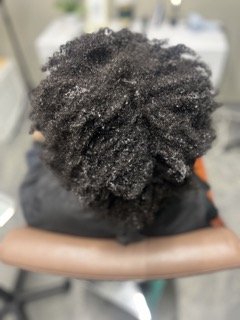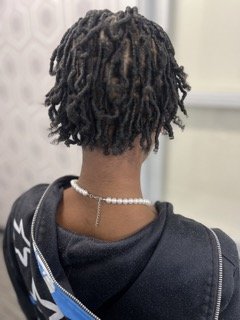So Are Locs For Kids?
I think its safe to say locs are becoming the thing for kids. As I serviced my back to school kid clients I noticed 70 percent of them had locs. Girls and boys. It totally amazed me how locs is becoming a more common in the beauty industry more than ever, even on kids. I would like to share how kids can embrace their natural hair while wearing locs. I’ll share how you can upkeep them and Maintence them so they can remain neat and presentable.
There are many reasons why people choose to start dreadlocks. For some, it is a way to express their individuality and embrace their natural hair texture. For others, it may hold cultural or spiritual significance. Whatever the reason, starting dreadlocks is a commitment that requires time, patience, and proper care. The first step in starting dreads is deciding on the method that best suits your hair type and desired outcome. There are several methods to choose from, including the coils, two stand twist, interlocking method, and backcombing. Each method has its own pros and cons, so it's important to do your research or request a consultation to get the proper assistance on which method will work for you based upon your lifestyle, hair type and texture.
What’s the goal? What do you see your locs looking like in the end? It’s great to think ending before starting. How you want you to see your locks in the ending will help with knowing how to apply the foundation and what methods to use when starting.
Take a look at the transformation of this loc client’s journey:
It's time to embark on your dreadlock journey. The first few weeks will involve frequent washing and separating of the hair to encourage the hair to lock and prevent the formation of unwanted knots. It's important to use residue-free shampoos and avoid products that contain wax or heavy oils, as these can hinder the locking process. As your hair begins to lock, you will notice that the texture and appearance of your dreads will change. It is normal to experience frizziness along the way. The locs will begin to loc from the inside out. This process usually takes 12 to 24 months to loc completely. Each texture is different. They may become tighter and more compact, and you may start to see the formation of loops and zig-zags. Embrace these changes, as they are a natural part of the dreadlock journey. In addition to proper washing and maintenance, it's important to develop a routine that promotes healthy, strong dreads. This may include regular palm rolling, which helps smooth the hair shaft and encourages uniformity in the locks. It's also recommended to avoid excessive manipulation of the hair, as this can cause breakage and damage to the locks. As your dreads mature, you will begin to appreciate the unique beauty and versatility that they offer.
Dreads can be styled in countless ways, from updos to buns to braids, allowing you to express your personal style in a truly unique way. However, it's important to note that the process of starting and maintaining dreads is not without its challenges. While some may experience a smooth transition, others may encounter issues such as thinning hair, breakage, or uneven locking. This is why it's important to seek professional advice and support, especially if you are new to the dreadlock journey. This will help so your locs can remain healthy and consistent as they grow out. When error happens to your locs during the locking stage this can be very expensive to fix later. So be sure to invest well.
Overall, starting dreads is a personal and transformative experience. It requires dedication, patience, and a willingness to embrace the changes that come with it. TRUST YOUR PROCESS. Try not to compare it to anyone else’s process. This takes the joy out of your journey. But for those who are willing to put in the effort, investment to take care of your locs, will see the end result is a beautiful and one-of-a-kind hairstyle that reflects their individuality and self-expression. As the popularity of dreads continues to grow, it's clear that this timeless hairstyle is here to stay.







